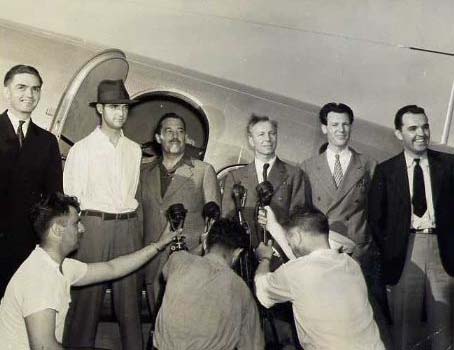Howard Hughes’ Robot
On his record-setting flight in 1938, the billionaire had two navigators, only one of which was human
/https://tf-cmsv2-smithsonianmag-media.s3.amazonaws.com/filer/6e/c1/6ec1a34c-8e71-4909-9944-6973e8e6db0e/howard_hughes_14-n2.jpg)
In 1938, Howard Hughes and his crew set a world record by circumnavigating the globe in just 91 hours (3 days, 19 hours). They took off from New York City in a Lockheed Super Electra, and co-pilot and navigator Thomas Thurlow wasn’t too happy with Hughes’ piloting:
When Howard first cracked the throttles, it felt to me like the ship was tied. I pushed with everything and swore at Howard for not pouring on more power in a hurry. I felt uneasy when we hit the runway and were doing only a scant twenty, if that. From then on the run lasted for an eternity. I was relieved when the ship felt light, but at the same time I knew we were about out of runway.
The aircraft was fitted with cutting-edge radio and navigational equipment, including a “navigation robot” invented by W.L. Maxon, which could calculate the user’s exact geographic location. Thurlow, then a lieutenant with the U.S. Army Air Corps, was “loaned” to Hughes for the record-setting attempt, as he understood how to use the Maxson navigator better than anyone.

The crew at the end of the record-setting flight. Lieutenant Thomas Thurlow is on the far right. Howard Hughes is second from left. Courtesy Tamara Thurlow Field.
It was the first time the device was used on a civilian airplane. If successful, it would be installed in Army bombers. “While the Hughes flight is a remarkable tribute to powerful and reliable motors,” noted the July 23, 1938 Science News Letter, “it is to this robot navigation computer that much of the success of the flight is credited. No matter how well a plane may fly, or how easily, it matters little if the navigators cannot, at all times, exactly fix the plane’s position and plot the proper direction over distances of thousands of miles.”
Thurlow’s granddaughter, Tamara Thurlow Field, has just published Thurlow’s diary of the attempt (Flying With Howard Hughes). While the diary isn’t very long, it provides a candid look at the billionaire pilot, and gives new details about the record-setting flight. Thurlow mentions that Hughes became uneasy as the aircraft approached Paris: “It is a natural reaction suffered by pilots who have not done a great deal of navigation flying in which the navigator has complete directional control of the airplane and the only knowledge of position,” wrote Thurlow. “I was amused, but felt guilty about it. Howard’s responsibility was a great one, and the obvious fatigue from which he was suffering was not helping matters any.”
The team’s effort would win Hughes the Harmon Trophy as well as the Collier.